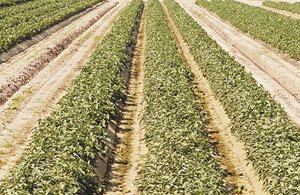Local agriculture in 2012 recovered some of the losses it suffered the previous year thanks to better weather patterns and steady demand for the region’s most voluminous commodities, according to the Santa Clara County Division of Agriculture’s annual crop report which was released earlier this week.
The gross value of crops and livestock raised in Santa Clara County in 2012 was about $261 million – a 5 percent increase from the $248 million value reported in 2011, the report said. In 2011, the County’s agriculture suffered a 7 percent loss from 2010’s value of about $266 million.
The County’s top three crops remain the same as the last decade-plus: Nursery crops ($83 million), mushrooms ($63 million) and bell peppers ($14 million). The latter two of these saw noticeable gains in 2012, while nursery crops saw a slight decline in value from 2011.
Making a comeback in South County is garlic, which broke into the top 25 most valuable local crops with a total value of $2 million in 2012, according to the report.
The 2012 crop report shows that local agriculture is eternally subject to fluctuating values, usually due to a variety of factors that are outside the growers’ and ranchers’ control, according to sources in the Santa Clara County farming industry.
“Agriculture is always in fluctuation in terms of prices,” said Executive Director Jennifer Scheer of the Santa Clara County Farm Bureau. “Growers need to continue to expect, and plan and be prepared for (fluctuations) because there’s always going to be unpredictable prices.”
The weather in 2012 was more favorable to certain local crops that are sensitive to irregular weather patterns – especially cherries, according to the crop report.
Growers in 2011 lost their cherries due to late-season rains that destroyed the entire local crop, according to Morgan Hill cherry grower Andy Mariani. But favorable weather in 2012 brought a comeback.
“2011 was almost a total wipeout, 2010 was a partial wipeout, and in 2012 the reason why we had a bigger crop is because we didn’t get any rain damage,” Mariani said.
As a result, the total value of cherries grown in the County in 2012 jumped to about $9 million, making it the fourth most valuable commodity last year, according to the crop report. In 2011, the reported value of local cherries was not even $2 million.
Heavy rains in May 2011 caused the nearly-ripe cherries’ skin to crack on the tree branches just before harvest time, Mariani explained. That makes the cherries unusable on the market, and most local growers that year didn’t even pick their cherries and instead collected insurance on their crops.
“In 2012, we were able to harvest everything,” said Ralph Santos, a Gilroy cherry farmer who owns El Camino Packing and operates Ralph’s Cherry Hut off Highway 101.
This year’s cherry harvest didn’t see any unfavorable weather, but growers don’t expect quite as sizable a crop as 2012. Cherry trees generally don’t produce consecutive large harvests, Santos said.
“I attribute it to having a really big year the year before. This year we had about 40 percent of what we had in 2012,” Santos explained.
Peppers – bell and chili varieties – remain successful in Santa Clara County as prices go up, prompting growers to devote even more acreage to those crops in 2012, County Agriculture Commissioner Joseph Deviney said.
Acreage for bell peppers went up from 1,466 in 2011 to 1,487 in 2012, and the price went up from $272 per ton to $334 per ton, according to the report.
Wax and chili peppers also saw noticeable increases in acreage and price in 2012.
“I think we have good bell pepper country here,” Deviney said. “They grow well, and the people who grow them are getting better at growing them. If they’re selling, and selling well and for good prices, they put in more acreage.”
While Deviney also pointed to the jump in local mushrooms’ value in 2012 (by about $2 million) as a factor in the overall increase in agriculture’s value, at least one grower said it could have been an even better year if not for a pest infestation at local farms.
Several local mushroom farms – especially the smaller ones – were plagued by an influx of phorid flies, which damage the fungus, according to Don Hordness, president of Royal Oaks Mushrooms in Morgan Hill.
The flies are attracted to the growing mushrooms, and breed inside the indoor farms, Hordness said. And the pesticides that growers used to use to keep the flies in check were banned by regulatory agencies before 2012.
“The good news is now we don’t use anything from a chemical standpoint,” Hordness said. “But it was kind of a tough year (in 2012). A lot of the small farms were affected. This year appears to be a little bit better. It’s exclusion – we have to keep the rooms really tight and buttoned up.”
Other crops that saw gains in 2012 were salad greens ($1.5 million gain) and beans ($500,000 gain).
Cut flowers saw a loss of about $2.5 million in 2012, and cattle saw a loss of about $200,000, according to the crop report.
Hordness explained there are numerous factors – largely economic – that contribute to fluctuations in prices of mushrooms and other agricultural commodities, and put a strain on Santa Clara County farmers.
For example, growing is cheaper on the East Coast than it is in California, so mushroom farmers there can “dump” their crop on the West Coast in a typical year, Hordness said.
Also, when the federal government started requiring a portion of corn production to go to ethanol a few years ago, that raised the price for materials for the compost stock on which fungus thrive, Hordness said.
And an impending challenge is the County Board of Supervisors’ interest in raising the local minimum wage, which County staff are currently studying to present to the board in August.
“Agriculture is really impacted by that,” Hordness said. “If you raise the minimum wage, you raise all your wages. It impacts everyone. Everything else goes up too.”
• 2010: $266M
• 2011: $248M
• 2012: $261M
Top commodities, 2012
• Nursery crops: $83.2M
• Mushrooms: $63.5M
• Bell peppers: $14M
• Cherries: $9M
• Wax and chili peppers: $8.3M
• Fresh tomatoes: $7M
• Salad greens: $7M
• Lettuce: $6.3M
• Beans: $6.1M
• Wine grapes, red: $5.2M















